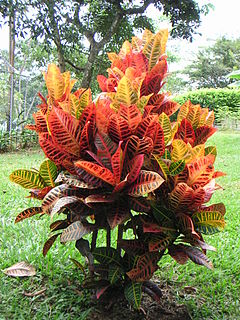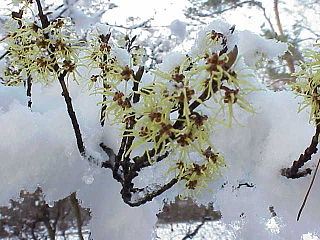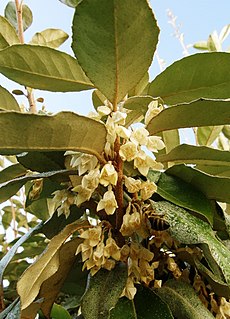
Salvia rosmarinus, commonly known as rosemary, is a woody, perennial herb with fragrant, evergreen, needle-like leaves and white, pink, purple, or blue flowers, native to the Mediterranean region. Until 2017, it was known by the scientific name Rosmarinus officinalis, now a synonym.

Carpenteria californica, the tree anemone or bush anemone, is a species of flowering plant in the hydrangea family Hydrangeaceae. It is the sole species in the monotypic genus Carpenteria, which is closely related to the similar genus Philadelphus. It is a flowering evergreen shrub native to the Sierra Nevada foothills in California.

Dianthus is a genus of about 300 species of flowering plants in the family Caryophyllaceae, native mainly to Europe and Asia, with a few species extending south to north Africa, and one species in arctic North America. Common names include carnation, pink and sweet william.

Pelargonium is a genus of flowering plants which includes about 200 species of perennials, succulents, and shrubs, commonly known as geraniums, pelargoniums, or storksbills. Confusingly, Geranium is the botanical name and common name of a separate genus of related plants. Both genera belong to the family Geraniaceae. Linnaeus originally included all the species in one genus, Geranium, and they were later separated into two genera by Charles L’Héritier in 1789.

Alstroemeria, commonly called the Peruvian lily or lily of the Incas, is a genus of flowering plants in the family Alstroemeriaceae. They are all native to South America although some have become naturalized in the United States, Mexico, Australia, New Zealand, Madeira and the Canary Islands. Almost all of the species are restricted to one of two distinct centers of diversity, one in central Chile, the other in eastern Brazil. Species of Alstroemeria from Chile are winter-growing plants while those of Brazil are summer-growing. All are long-lived perennials except A. graminea, a diminutive annual from the Atacama Desert of Chile.

Hypericum calycinum is a species of prostrate or low-growing shrub in the flowering plant family Hypericaceae. Widely cultivated for its large yellow flowers, its names as a garden plant include Rose-of-Sharon in Britain and Australia, and Aaron's beard, great St-John's wort, creeping St. John's wort and Jerusalem star. Grown in Mediterranean climates, widely spread in the Strandja Mountains along the Bulgarian and Turkish Black Sea coast, and also in Flanders in Belgium.

Prunus serrulata or Japanese cherry, also called hill cherry, oriental cherry, East Asian cherry, is a species of cherry native to China, Japan and Korea, and is used for its spring cherry blossom displays and festivals. Current sources consider it to be part of a species complex with P. jamasakura and P. leveilleana, which have been reduced to synonyms.

Strelitzia reginae, commonly known as the crane flower or bird of paradise, is a species of flowering plant indigenous to South Africa. An evergreen perennial, it is widely cultivated for its dramatic flowers. In temperate areas it is a popular houseplant.

Euonymus japonicus is a species of flowering plant in the family Celastraceae, native to Japan, Korea and China. It is an evergreen shrub or small tree growing to 2–8 m tall, with opposite, oval leaves 3–7 cm long with finely serrated margins. The flowers are inconspicuous, greenish-white, 5 mm diameter. In autumn, orange fruit hangs below the flaring pink seed coverings.

Lamprocapnos spectabilis, bleeding heart or Asian bleeding-heart, is a species of flowering plant in the poppy family Papaveraceae, native to Siberia, northern China, Korea and Japan. It is the sole species in the monotypic genus Lamprocapnos, but is still widely referenced under its old name Dicentra spectabilis. It is valued in gardens and in floristry for its heart-shaped pink and white flowers, borne in spring.

Kerria japonica, also known as the Japanese marigold bush or miracle marigold bush in the northern New England area and as yamabuki (山吹) in Japan, is a deciduous shrub in the rose family Rosaceae, native to China, Japan and Korea. It is named after William Kerr, who introduced the cultivar 'Pleniflora'. It is the sole species in the genus Kerria; its genus name is also used as a common name (kerria).

Camellia sasanqua, with common name sasanqua camellia, is a species of Camellia native to China and Japan. It is usually found growing up to an altitude of 900 metres.

Codiaeum variegatum is a species of plant in the genus Codiaeum, which is a member of the family Euphorbiaceae. It is native to Indonesia, Malaysia, Australia, and the western Pacific Ocean islands, growing in open forests and scrub.

Hamamelis mollis, also known as Chinese witch hazel, is a species of flowering plant in the witch hazel family Hamamelidaceae, native to central and eastern China, in Anhui, Guangxi, Hubei, Hunan, Jiangxi, Sichuan, and Zhejiang.

Farfugium japonicum syn. Ligularia tussilaginea is a species of flowering plant of the family Asteraceae, also known as leopard plant or green leopard plant. It is native to streams and seashores of Japan, where it is called tsuwabuki (石蕗).

Argyranthemum frutescens, known as Paris daisy, marguerite or marguerite daisy, is a perennial plant known for its flowers. It is native to the Canary Islands. Hybrids derived from this species are widely cultivated as ornamental plants in private gardens and public parks in many countries, and have naturalized in Italy and southern California. There are many cultivars, but the most common has white petals.

Geranium subcaulescens is a species of flowering plant in the geranium family Geraniaceae, that is native to Italy, Turkey and the Balkans. A low, mounded evergreen perennial, it typically grows to 8 in (20 cm) tall by more than 11 in (28 cm) broad, with grey-green orbicular and lobed leaves, and masses of bright magenta pink flowers with black centres in summer.

Halimium lasianthum, the Lisbon false sun-rose or woolly rock rose, is a species of flowering plant in the family Cistaceae, native to southern Portugal and southern Spain. It is a spreading evergreen shrub growing to 1 m (3 ft) tall by 1.5 m (5 ft) wide, with grey-green leaves and bright yellow flowers in spring. The flowers may have a maroon blotch at the base of each petal.

Elaeagnus × submacrophylla, formerly known as Elaeagnus × ebbingei, is a hybrid between Elaeagnus macrophylla and Elaeagnus pungens. Several cultivars, including 'Gilt Edge', are grown in gardens as ornamental plants. Both the hybrid and 'Gilt Edge' have gained the Royal Horticultural Society's Award of Garden Merit.

Garden marguerites, also known as marguerite daisies, are cultivars of plants in the subtribe Glebionidinae of the family Asteraceae, the great majority being hybrids created in cultivation. One of the genera belonging to the subtribe, Argyranthemum, was introduced into cultivation from the Canary Islands in the 18th century, and modern cultivars are mostly sold and grown under the genus name Argyranthemum or the species name Argyranthemum frutescens, although many are actually intergeneric hybrids. The first such hybrids involved species now placed in the genus Glebionis, but other crosses within the subtribe are known. Breeding has aimed at introducing flower heads in varied colours and shapes while retaining the shrubby habit of Argyranthemum. Garden marguerites are used as summer bedding or grown in containers. Most are only half-hardy. They can be trained into shapes such as pyramids or grown as standards.




















